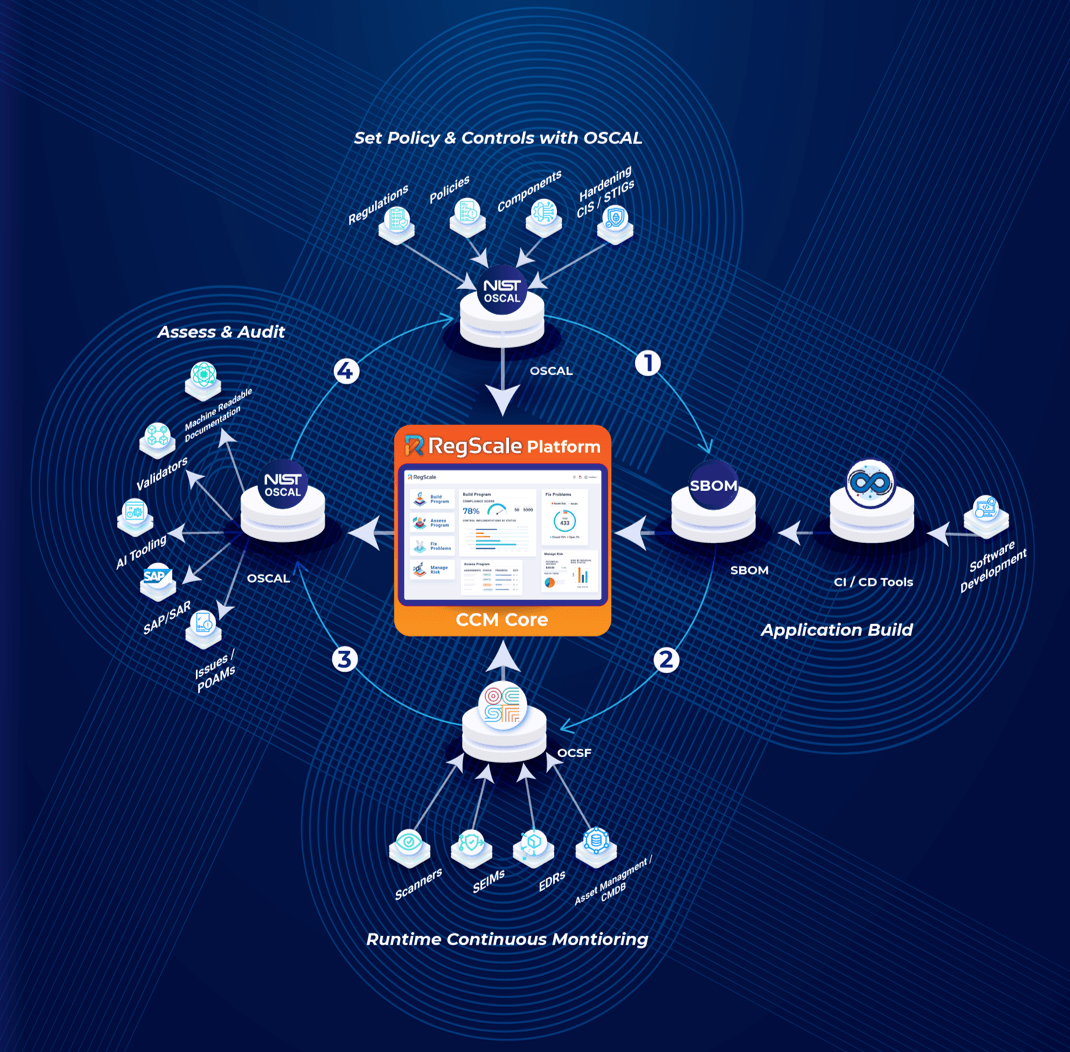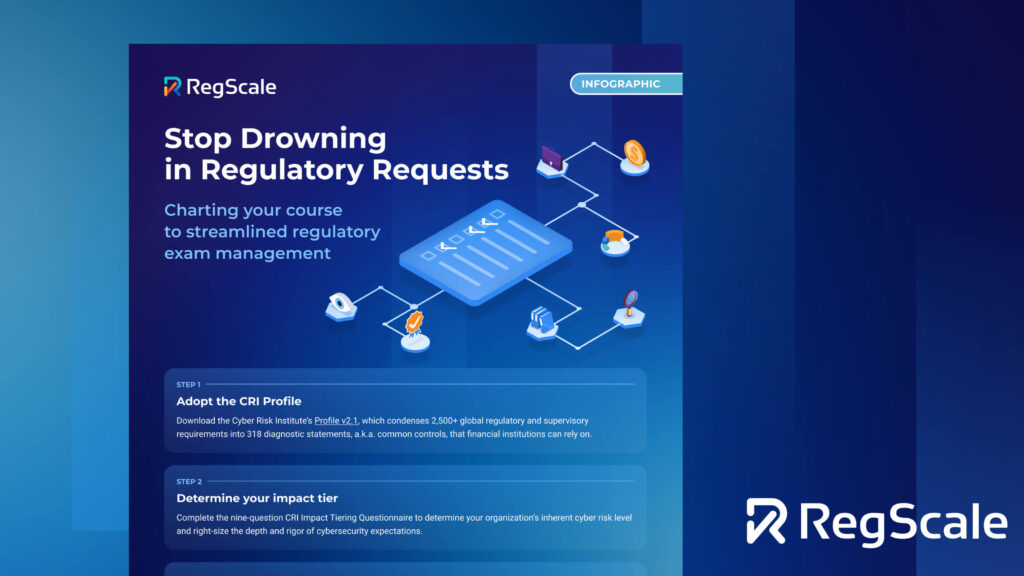Why Continuous Compliance Automation Is More Essential Than Ever

Whether you’re ordering a meal in a restaurant or paying for parking, there’s an app for that. The explosion of apps and the fierce competition for users has driven development to new speeds — and software teams are shipping code faster than ever to keep up.
At the same time, compliance requirements keep growing, and developers are dealing with more regulations, security standards, and internal policies than ever before. Manual compliance checks can’t keep up with this breakneck pace, creating risky gaps that can hurt both the business and its customers.
Continuous Compliance Automation (CCA) is a rapidly growing market that’s addressing the speed of modern development by helping companies automatically monitor and enforce internal policies and regulations. With the help of CCA technology, both Cybersecurity and DevOps CCA, from companies like RegScale, mentioned as a sample vendor for the third year in a row in Gartner® Hype Cycles™ for Cyber-Risk Management, 2025*, I&O Automation, 2025*, Site Reliability Engineering, 2025*, and Agile and DevOps, 2025*, compliance and risk management have become a seamless part of the DevOps process.
This blog unpacks the need for CCA, explores the challenges and drivers behind its adoption, identifies key roadblocks, and provides actionable advice for organizations seeking to make compliance smarter, not harder.
Today’s Need: Compliance Can’t Keep Pace with Development
The regulatory landscape is exploding in complexity and volume, and not just for the usual suspects in highly regulated industries like Finance, Government, and Healthcare. From NIST and SOC 2 to PCI-DSS and FedRAMP, compliance mandates touch every part of nearly every enterprise—IT, product, security, and beyond. Compounding the challenge is the acceleration of agile development and cloud-native infrastructure, where deployments happen daily or hourly.
Continuous Compliance Automation (CCA) has emerged as the critical solution. Two important segments of CCA are:
- Cybersecurity CCA (CCCA): Focuses on automating evidence collection, integrating with security tools, and streamlining audits for risk and compliance leaders.
- DevOps CCA (DCCA): Embeds compliance enforcement directly into the software delivery lifecycle, enabling policy enforcement, secure toolchains, and audit-ready pipelines.
Both approaches reflect a growing realization: compliance is no longer a periodic task—it must be continuous, contextual, and code-integrated.
And Yet, Enterprises Experience Compliance that is Manual, Siloed, and Costly
Despite its criticality, compliance remains one of the most manual, error-prone, and resented activities across organizations. Every regulatory framework requires evidence, or proof, that the requirements are being met in a satisfactory manner. Many of these requirements are duplicated across frameworks. For every audit, you will be asked to prove what you just proved, two, three, maybe even ten times before. And because changes to regulations can occur at any point, the evidence you just used yesterday may not be valid today. Challenges include:
- High audit fatigue from repeated evidence collection and lack of reuse.
- Disjointed tooling and a lack of integrations across security, IT, and DevOps systems, eliminate 200+ hours per quarter embedding Compliance-as-Code into your CI/CD pipeline.
- Slow responsiveness to new frameworks or policy changes, automation saves 80% effort and cost over manually onboarding new frameworks.
- Communication gaps between compliance experts, stakeholders and investors, and control owners or developers.
- Manual reporting lags behind fast-moving development and business cycles.
- High cost of fixing errors once audit packages are sent to auditors, AI and automation is 60% less expensive than engaging in manual audits.
- Increased barriers to new markets slowing business growth and ceding the competitive advantage.
These inefficiencies translate to real risks—missed audits, failed certifications, and reputational harm.
Business Drivers: Organizations Start Automating
There is more emphasis put on being compliant and greater penalties for failing to meet regulatory obligations. Fines in the EU can be up to €20 million or 4% of the organization’s total worldwide annual turnover for the preceding financial year, whichever is higher. This is causing a surge in CCA adoption to address critical pain points:
- Growing regulatory pressure: With frameworks expanding and evolving, manual tracking fails to scale.
- DevOps acceleration: Continuous delivery demands continuous compliance—manual controls simply can’t keep up.
- Audit readiness expectations: Stakeholders, from regulators to investors, expect real-time visibility into compliance posture.
- Security maturity: Automation enables early detection of misconfigurations and security gaps and provides paths to automate remediation.
- Cost and resource efficiency: CCA eliminates duplicate effort, reduces audit prep time, and reallocates skilled personnel to higher-value work.
In short, CCA embeds compliance into development cycle and helps organizations stay compliant, move fast, and reduce risk—simultaneously.
Obstacles to Adoption: Organizational Quicksand
Despite its promise, CCA implementation isn’t just about plug-and-play. Technology hurdles are just one of many to overcome. There is also a shift in mindset that is required to encourage greater collaboration between the compliance and DevOps teams, often seen as the tortoise and the hare respectively, so they each understand the value the other brings to the process. The need to balance speed, security, risk management, and compliance requires cooperation across the organization:
- Integration complexity: Not all systems have available or mature APIs.
- False confidence: Assuming automation equals compliance without governance or oversight.
- Toolchain readiness: DCCA requires secure, change-managed pipelines and disciplined DevOps processes.
- Lack of SME involvement: Implementing without compliance and GRC collaboration leads to misaligned rules, failures and potential security and risk issues.
- Interpretation risk: Auditors may still rely on subjective judgment, especially when evaluating AI-generated or automated outputs.
Successful CCA requires not just tooling—but culture, process, and stakeholder alignment. Leaving silos in place leads to blind spots in compliance and security, putting the entire organization at risk of brand damage, loss of customer data, and regulatory fines. One customer took a head-on approach to transforming its DevSecOps and compliance programs. Utilizing Policy/Compliance-as-Code within their CI/CD tooling, they were able to find compliance and vulnerability issues sooner in the software development process, and fix the issues faster, resulting in less impact on software delivery. Embedding compliance into the DevSecOps pipeline enabled them to apply consistent metrics, KPIs, and runbooks across regulatory frameworks and compliance programs. This consistency provides reports and dashboards with accurate, real-time security and compliance posture, and increases both the quality and velocity of software delivered to customers.
Decision Guidance: A Quick Start Guide
Organizations evaluating CCA should approach it like any strategic transformation, understanding that change must be incremental and that there will be growing pains. Once you have everyone onboard, here’s where you can begin:
- Define your compliance scope: What frameworks do you follow? What’s your audit cadence? Where are your biggest risks or inefficiencies?
- Audit your current tooling: Some platforms may already offer automation capabilities you can build on.
- Prioritize high-impact use cases: Start with evidence collection, control assessments, and reporting.
- Map ownership and accountability: Identify control owners, evidence providers, and auditors—and define roles in your automated system.
- Involve GRC and DevOps early: Co-design automation policies, rules, and integrations for maximum effect and buy-in.
- Evaluate vendors holistically: Look beyond features—consider integration flexibility, scalability, and support for external auditors or partners.
Critical Features for Success: The Essentials in a CCA Solution
Regardless of your starting point, a successful CCA platform must support:
- Broad framework coverage: Support for major regulatory frameworks (e.g., NIST, ISO, SOC 2, FedRAMP, HIPAA). Few organizations today only need to adhere to a single framework to be successful. The more frameworks, the more complex the requirements, and the more CCA benefits everyone.
- AI-assisted compliance mapping: Intelligent mapping of frameworks to controls, reducing manual interpretation and subjectivity, and alleviating regulatory pressures taking on new frameworks.
- Automated evidence collection: Ingest artifacts from security, IT, and cloud tools with context-aware matching, no more guessing if you have the right evidence for the right control at the right time.
- Role-based access and workflows: Ensure the right people see the right evidence at the right time and map ownership to accountability.
- Integration with DevOps pipelines: Embed controls in CI/CD workflows with real-time policy enforcement, enabling compliance and security to scale at the speed of development.
- Real-time dashboards and reporting: For audit readiness, board reporting, and proactive remediation, business leaders make better decisions with complete information.
- Support for external auditors and partners: Enable collaboration without compromising internal processes or security, add consistency to audits, removing subjectivity from audit to audit.

Look for platforms that are leading the way by combining AI-driven control logic, developer-friendly automation, and policy-as-code to make continuous compliance practical at enterprise scale.
Final Thoughts: Compliance Is No Longer a Barrier. It’s a Differentiator.
Compliance doesn’t have to slow innovation—it can accelerate it. By embedding trust and transparency into your processes, CCA not only reduces overhead but also becomes a driver of business agility and stakeholder confidence.
The future of GRC is real-time, risk-informed, and developer-integrated. The future is Continuous Compliance Automation.
Built on an OSCAL and continuous compliance automation foundation, RegScale brings seamless integration, unparalleled visibility, and actionable insights to organizations who need to shift compliance left for faster, more cost effective, more secure development processes. We’ve helped a global organization cut $18M and 2k person hours in the first year integrating into DevSecOps pipelines. We can do the same for you.
Ready to see how RegScale can accelerate your organization’s embrace of continuous compliance automation? Learn more here.
*Gartner has done considerable research on this topic, with some of the relevant research listed below. Note you must be an active Gartner member to read the research.
Hype Cycle for Cyber Risk Management, 2025
Hype Cycle for I&O Automation, 2025
Ready to get started?
Choose the path that is right for you!
Skip the line
My organization doesn’t have GRC tools yet and I am ready to start automating my compliance with continuous monitoring pipelines now.
Supercharge
My organization already has legacy compliance software, but I want to automate many of the manual processes that feed it.
